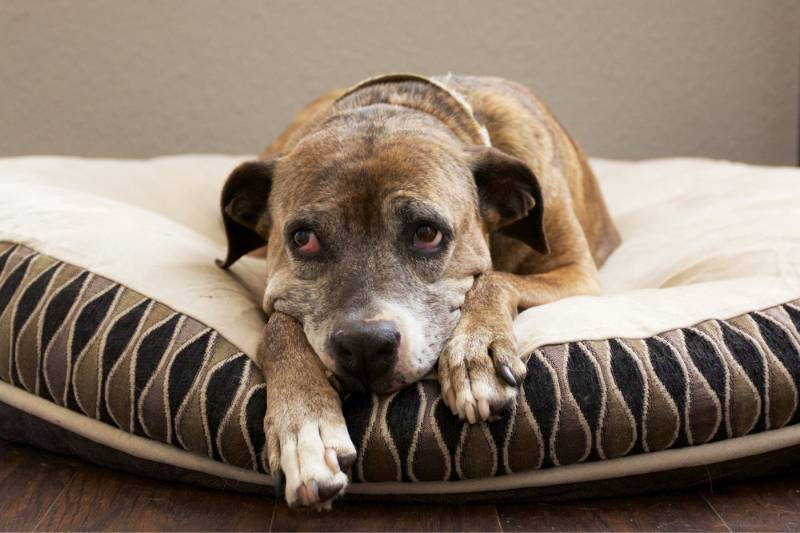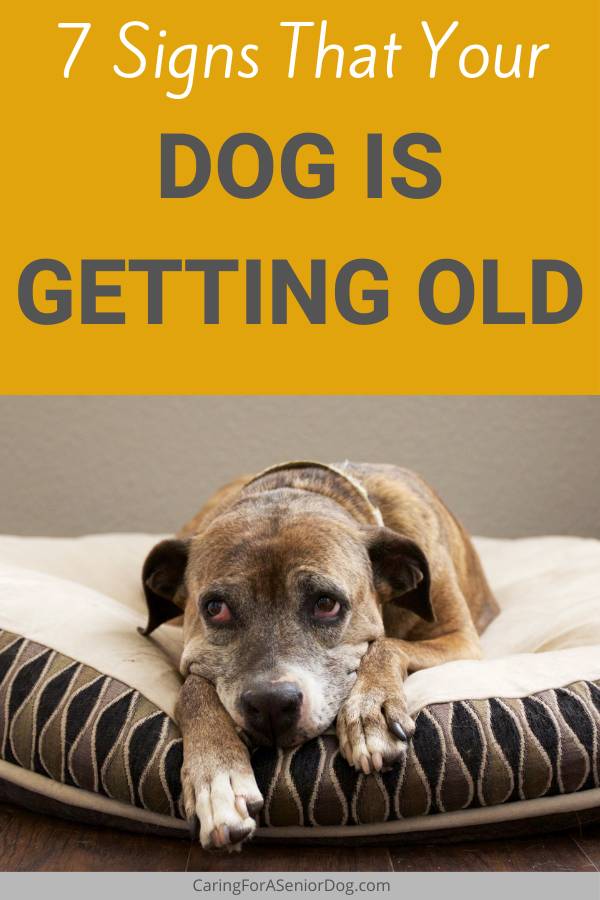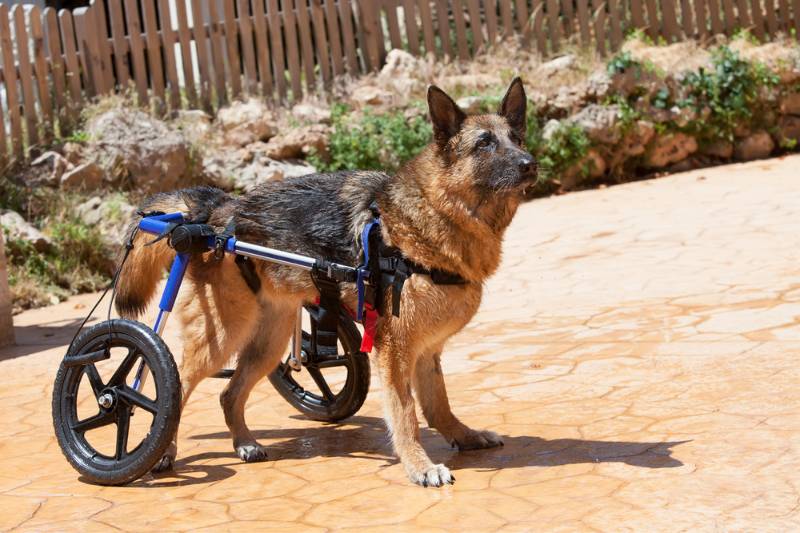For many dog owners, admitting their dog is entering their senior years can be difficult.
It makes us realize that they are closer to the end of their lives than they are to the beginning.
Neglecting to accept the fact that your dog is aging, however, can mean that you miss important indicators that signify they are experiencing a health issue that requires attention.
The sooner you address any problems, the better for your dog.
While painful to acknowledge, admitting that your dog is aging is truly best for their health, longevity, and quality of life.
Recognizing the signs of aging and what to expect in a senior dog and knowing how to properly care for an old dog will allow you to give them the best possible care in their golden years.
Disclosure: Some of the links in this article are affiliate links (Amazon Associate or other programs we participate in). As an affiliate, I earn a small commission from qualifying purchases.
What to Expect in an Aging Dog
The age when a dog is considered a senior depends on their size and breed.
Great Danes are considered old at around six years old, while smaller dogs like Dachshunds enter their senior stage a few years later.
Genetics and lifestyle also play a role in your dog’s progression into old age.
More active dogs may be able to continue their normal activity levels well into their senior years, while others may require cutting back.
Watching your dog grow old is difficult, but admitting that they’re not a spring chicken any longer is among the most important things you can do for your aging dog.
If you stay in denial, you may miss crucial signs of aging, which can indicate diseases, illness, and pain.
Changing your mindset that your dog is getting older will open your eyes to the changes you will inevitably see in your dog.
Seven Signs Your Dog Is Getting Old
A graying muzzle is an easy-to-spot sign that your dog is getting old, but it is by no means the indicator.
In fact, some dogs (especially brown ones) may start to grey as early as four years old, well before they are considered a senior dog.
You know your dog better than anyone, so your job is to recognize signs of aging and act accordingly in the interest of your dog’s health.
Keeping an eye out for the signs listed below will help you identify potential problems earlier rather than later, which can make a difference in their longevity.
If and when you notice any of the signals below, consult your veterinarian to diagnose the cause and create a plan together to manage the problem.
1. Loss of Senses
As they age, your dog may begin to lose their sense of sight, hearing, or smell.
Some dogs may become fully deaf or blind, but this may be preventable. Taking your dog to the vet at the first sign of loss of a sense can help delay or prevent a complete loss.
Many dogs will begin to develop cloudiness in their eyes as they age.
This is called nuclear sclerosis and does not necessarily indicate that your dog is going blind.
It can, however, lead to other ocular diseases like cataracts, so talk to your vet if you notice cloudiness.
Hearing loss is common and not always noticeable in the beginning.
Signs include startling easily, especially when approached or not responding to commands or their own name.
Avoid sudden movements and approaching your dog from behind.
2. Decreased Mobility and Endurance
One telltale sign of aging in dogs is decreased mobility and endurance.
Where your dog may have recently been able to join you for a 10-mile hike or trail run, you may start to notice that they’re lagging behind, require more rest, or move a little more tenderly.
These are signs that they need to reduce their mileage.
Consider breaking walks into shorter, more frequent outings or switching to a lower-impact exercise, like swimming.
Older dogs may also develop joint pain and stiffness, sometimes due to arthritis.
Dogs notoriously hide their pain well, so by the time you start to see them struggle with everyday activities like getting up from their bed, jumping into the car, or onto the couch, it’s likely that they’ve been experiencing pain for some time.
You may also want to consider an orthopedic bed that distributes weight evenly and a joint supplement with glucosamine and chondroitin.
3. Incontinence
You may notice that your dog needs to go potty more often or has more accidents in the house.
Incontinence is common in senior dogs.
As frustrating as it may be for you to increase potty breaks or clean up after your dog more often, remember that it’s no picnic for them, either.
Incontinence can indicate other ailments, such as infections or kidney disease, if accompanied by increased water intake.
If you find it challenging to keep up with cleaning the accidents, consider investing in a few dog incontinence products to make your life a bit easier.
4. Fatty Lumps
Lumps and bumps of all sizes are likely to develop as dogs age. Finding a lump can certainly be scary, and your mind will undoubtedly go to cancer.
Often, these are just harmless fatty lipomas that form under the skin. Cancerous tumors tend to stay in place, while fatty deposits will move around.
Regular checks (do them in the form of a nightly massage, and your dog will love them!) will help you catch them as soon as you can feel them.
If you suspect an abnormal lump, take your pup to the vet to rule out a tumor.
5. Oral Issues
While dogs don’t aren’t typically known for their minty fresh breath, it tends to worsen as they get older due to increased oral health issues.
Terrible dog breath can indicate gum disease, tooth decay, or other oral infections.
Common signs include:
- Decreased appetite
- Moodiness
- Swollen and red gums
- Bad breath
You’ll want to schedule a visit with the vet to nail down the cause.
They may require a teeth cleaning or surgery to remove an infected tooth.
6. Weight Changes
Keep an eye on your dog’s weight as they age.
Increased weight gain can result from decreased activity. If you cannot increase activity, talk to your vet about reducing their food portions or putting them on lower-calorie food.
Weight loss in aging dogs is especially concerning because it can indicate several problems, such as:
- Reduced muscle mass
- Inability to absorb nutrients from food
- Digestive illnesses
If your dog has lost more than 10 percent of their body weight within a few months, get them to the vet to see what might be going on.
7. Cognitive Impairments
Canine Cognitive Dysfunction (CCD) syndrome is often called dog dementia.
As dogs age, their brains may lose cognitive features like memory, responsiveness, and awareness of their surroundings.
Common behavioral changes in dogs with dementia include:
- Confusion
- Excessive barking
- Moodiness
- Lack of grooming
- Changes in sleep cycle
- Repetitive or compulsive behaviors
- Incontinence
In the early stages, it is possible to manage CCD with the help of supplements and diet, continued mental stimulation and exercise, and medication. However, there is no cure for the syndrome.
How to Care for an Older Dog
Just because your dog is in their senior phase of life, it doesn’t necessarily mean that you need to put your dog out to pasture or into retirement. It just means you must keep a keen eye on their behavior and adjust accordingly.
Maintaining essential health routines, like exercise, diet, and mental stimulation will keep your dog powering through those senior years with zest!
Taking care of an older dog may mean changing your lifestyle or home routines if you want to continue to include your dog in your regular activities.
For example, if you love backpacking but your trail buddy can no longer join you, you may plan more car camping trips to accommodate them.
A few key changes to make as your dog ages could include:
- Letting them sleep more often
- Upping mental stimulation
- Including more whole foods in their diet
- Maintaining their weight
- Daily brushing and grooming
- Checking their teeth and mouth regularly
Incorporating these simple changes will keep your dog more comfortable and help you stay better in tune to notice any changes in health.
Conclusion: Signs of Aging in Dogs
To help our dogs thrive in their senior years, we must be attuned to the changes they experience as they cage.
By understanding and recognizing these signs that your dog is getting old, you can provide the extra care and support they require.
Regular veterinary check-ups, awareness of the changes your dog is experiencing, and changes to your routine to accommodate their needs are all crucial at this stage of their lives.
Most importantly, cherish this time together.



 How to Tell a Dog is Dying of Old Age and What to Expect
How to Tell a Dog is Dying of Old Age and What to Expect
Leave a Reply